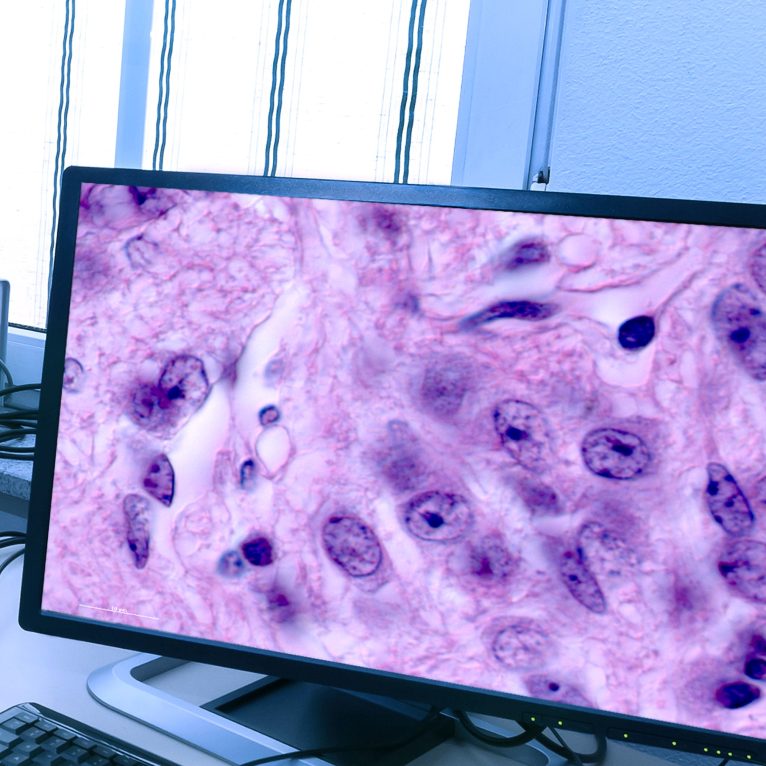
Written by

Cranfield, UK, 22nd April 2024, USCAP’s annual meeting is one of the largest annual gatherings of pathologists globally, so when landing in Baltimore this year for the 113th event, we were eager to connect with industry leaders old and new to discuss their take on the ‘pulse’ of the conference and what it meant for the future of clinical pathology.
Most whole-heartedly agreed that year-on-year digital pathology seems to dominate more and more of the conversation; and with that in mind we’ve shared below our top 3 insights for the future of the industry.
1. Cost Concerns Remain Front of Mind for New Adopters
Whilst growth in the clinical market remains impressive, it’s no secret that much of the US laboratory landscape is a greenfield opportunity for digital pathology.
Examples of large, successful implementations have helped drive confidence in digital workflows recently, leading to many larger academics and reference labs starting to mature and consider ‘next steps’. Yet, uptake amongst hospital labs remains noticeably slower, as stakeholders in these institutions remain concerned about recouping value from investments.
This is partially due to recent economic headwinds that have driven up labour and running costs in most of these institutions. When combined with reduced reimbursement rates and the added threat of laboratory developed test (LDT) regulation looming, some potential customers now have serious concerns about future profitability.
This hasn’t acted to completely stagnate growth, but it has put pressure on some vendors who are now being asked more about the return-on-investment (ROI) and value that digital pathology can provide. We have discussed the various direct and indirect forms of value digital pathology offers in a previous insight here, but it’s clear that most providers are asking for more than just indirect metrics like prestige and innovation, instead wondering ‘how will this help me improve my cashflows?’
Regardless of justification, before the pandemic sparked renewed interest in digital workflows, the large upfront investment required to go digital was arguably the main inhibitor to market growth. It’s no surprise therefore that cost remains a significant barrier in today’s market, especially for the scanner segment.
One signal that this may change soon however, is the increasing presence of more cost-competitive vendors within USCAP, as well the looming spectre of regulatory approvals that may currently be pending.
Three FDA approvals (Proscia, Hologic, Scopio Labs) have been announced so far in 2024 and it was very clear from walking the show floor that vendors were taking regulation seriously, which some even advertising publicly that FDA approval was expected soon.
Should all these vendors succeed in gaining approval this year, there’s no doubt that the US market will become more competitive, and vendors may be faced with a hard choice: innovate above peers to maintain pricing or compete to target more cost-conscious segments.
2. An Increasing Focus on Workflow, Ergonomics and the User Experience
Whilst there were relatively few brand-new product announcements and partnerships this year, innovation around the exhibit floor was not lacking.
There was a notable shift towards vendors applying a heavy focus on improving workflows and the ergonomics of their solutions for providers. This is a very real signal that the market is starting to mature and become more attuned with the demands of clinical users.
This will be crucial for the future development of the industry. Whilst scanner presence in labs remains low, the number of labs that are processing >75% of cases digitally is even lower. For the market to continue growing beyond the next five years, it’s crucial that solutions be intuitive to allow users to begin more easily processing higher volumes. Physician burnout created by clunky EHR systems is a well-known fact in healthcare and without reimbursement or financial incentives from government schemes for adoption, digital pathology would do well to ensure that its users do not experience the same challenges.
Examples of amendments in product portfolios included updated software views which became more tailored to each user profile, automatic features for pre-processing images to order worklists and assign cases, and an increased focus on the quality of LIS integrations as well as cloud deployments.
Each of these examples is designed to simplify the digital pathology workflow for users, addressing past gripes associated with the initial stages of digitisation. However, it’s not just users that would value simplification when adopting digital pathology.
AI was a very popular topic of conversation on the show floor, and with the presence of so many vendors delivering a portfolio of solutions, it’s not hard to see why. Differentiating between vendors, therefore, can be a challenge for users.
Gestalt Diagnostics launched an AI Algorithm Evaluator which is intended to address this challenge at the show. The software allows different AI vendor’s algorithm outputs to be viewed side by side, simplifying comparisons.
We’ve publicly discussed previously how we expect IMS platforms to begin evolving to become a central liaison between customers and third-party AI companies. IMS will have an increasingly important role in guiding its customers towards AI deployment. Software like this is a useful tool to help stakeholders choose the best solution for their labs and will drive superior products also.
3. The Elephant in AI’s Room
Finally, the future of the AI market in digital pathology was certainly a hot topic during this event. Whilst excitement and interest around the potential of AI remains high, providers still seem wary of committing too much to any one vendor.
Instead, the market seems to be opting to trial multiple algorithms before committing funds, and this cautious attitude has created some anxiety. AI vendors, which typically have acquired private funding to allow them to scale, are hoping to pay dividends to their sponsors soon, whilst providers seem wary about committing too much to one vendor that may not still be active in the market in years to come.
Whilst we’ve previously commented on the AI market and its inevitable consolidation, we also want to emphasise that this doesn’t mean that revenue for AI in Digital Pathology won’t grow. Some vendors have already reported fantastic growth for Q12024, expecting to triple revenues this year compared to last! Qritive is an example of another vendor which has announced customer wins in India recently, with others also reporting good traction.
Whilst the investment landscape is slow, this is something we expected after a strong 2021. Relative hype post-pandemic was strong, and many new investors didn’t fully understand the challenges that were associated with digital pathology adoption, nor the real reasons that interest had spiked.
For this reason, stakeholders are now looking for more proof of recurring revenue before coughing up further funds. The doors for further investment aren’t sealed shut, and we expect to hear more round announced publicly as 2024 continues.
In Conclusion, the Future’s Bright, but not Easy
It’s always difficult to ascertain when and if a market will take flight. Recent progress however indicates that the future for digital pathology is still bright. FDA approvals, announcements of adoption at key opinion leader sites and vendor growth all indicate that momentum for digital pathology is persisting.
The trick to success therefore lies in understanding the market’s evolution with as much granularity as possible, whilst focusing investment and R&D on things customers will be able to benefit from today.
Some have commented that this year’s event was uneventful compared to the slew of exciting announcements that came last year.
However, each step on the path to market maturity counts, and before they focus on what digital pathology could be, vendors need to demonstrate to providers the benefits more clearly and evidence of digital pathology in practice now.
Related Research
Digital Pathology Market Intelligence Service – World – 2024
Signify Research’s Market Intelligence Service provides a rolling 12-month coverage of the global Digital Pathology market. The service is composed of four deliverables, as shown below.
| Report | Report Type | Content |
| USCAP | Show Report | Signify Research’s analysis and key takeaways for new products, vendor strategies, technology innovation and major announcements during the annual USCAP conference. |
| Core Data Update and Full Report | Core Report | In-depth 100+ page pdf report with detailed market estimates and forecasts, key assumptions, market share analysis, company profiles and vendor SWOT analyses. Delivery includes interactive Excel database and Powerpoint Executive Summary. |
| Telepathology | Topical | Qualitative report offering a deep-dive into the telepathology market, including an evaluation of the different types of systems and ‘Digital-Pathology-as-a-Service’ business model. Guidance will be provided on the opportunity for growth and strategic recommendations for vendors will be outlined. |
| Pathology Visions | Show Report | Signify Research’s analysis and key takeaways for new products, vendor strategies, technology innovation and major announcements during the annual DPA conference. |
| Emerging Technologies | Topical | Qualitative report offering a deep-dive into the emerging technologies in digital pathology, including advanced scanning techniques, multiplex imaging and spatial biology analysis, robotics and multimodal data integration. Signify Research will provide an overview of each technology and its maturity, outline the opportunity for each and provide strategic recommendations for vendors. |
This core market update, the first of four publications included as a part of the service, builds upon five years of previous research, and will enable you to:
- Inform product investment and business strategy
- Evaluate the ever-changing competitive landscape to assess the impact of associations and select potential partners
- Acquire a holistic view of the nuances between different pathology research and clinical markets
- Understand adjacent markets such as enterprise imaging, laboratory information systems and the influence these will have on Digital Pathology
For any further questions, or samples of the service contents, please contact the Imogen Fitt, the report author.
About Imogen Fitt
Imogen joined Signify in 2018 as part of the Healthcare IT team. She holds a 1st class Biomedical Sciences degree from the University of Warwick where her studies included molecular biology and pharmacology. Since joining the team Imogen has studied the medical imaging software and hardware markets and is now expanding Signify Research’s Diagnostics and Lifesciences coverage.
About the Diagnostics and Lifesciences Team
The Diagnostics and Lifesciences team provides market intelligence and detailed insights on the multiple healthcare technology markets where the clinical world intersects with the preclinical. Our areas of coverage include digital pathology, laboratory information systems, clinical Real-World Data (cRWD) platforms, oncology information systems, tumour board software, oncology decision support software and radiotherapy IT. Each report provides a data-centric and global outlook of its markets with granular country-level insights. Our research process blends primary data collected from in-depth interviews with healthcare professionals and technology vendors, to provide a balanced and objective view of the market.
About Signify Research
Signify Research provides healthtech market intelligence powered by data that you can trust. We blend insights collected from in-depth interviews with technology vendors and healthcare professionals with sales data reported to us by leading vendors to provide a complete and balanced view of the market trends. Our coverage areas are Medical Imaging, Clinical Care, Digital Health, Diagnostic and Lifesciences and Healthcare IT.
Clients worldwide rely on direct access to our expert Analysts for their opinions on the latest market trends and developments. Our market analysis reports and subscriptions provide data-driven insights which business leaders use to guide strategic decisions. We also offer custom research services for clients who need information that can’t be obtained from our off-the-shelf research products or who require market intelligence tailored to their specific needs.
More Information
To find out more:
E: enquiries@signifyresearch.net
T: +44 (0) 1234 986111
www.signifyresearch.net

